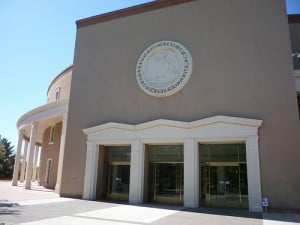
The Roundhouse in Santa Fe (Photo by Peter St. Cyr)
Public corruption took a big hit in New Mexico in 2009 with the indictments of several people in high-profile cases including the housing authority scandal. In addition, the state Legislature finally moved on some long-sought transparency issues, which proponents say will make it more difficult to engage in the sort of in-the-dark decision making that can breed corruption.
The worst economic downturn since the Great Depression also consumed many headlines and much of the public debate in New Mexico in 2009. However, the Legislature and governor have yet to take concrete steps to fully address the state’s ominous budget shortfall.
Heading into 2010, public corruption, the economy and the November election loom large. In the meantime, here are my picks for the top 10 political stories of 2009:
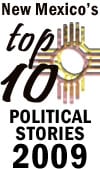
10. Health-care reform
The debate over health-care reform consumed a great deal of time in Washington in 2009, and U.S. Sen. Jeff Bingaman, D-N.M., was at the center of it. As one of the so-called “Gang of Six” – a bipartisan group of senators trying to negotiate a compromise – Bingaman fought hard, albeit unsuccessfully, for a public option to be included in the Senate version of the bill.
The year ends with the House and Senate passing very different reform bills and a lot of negotiating left to be done before the president has an opportunity to sign any health-care reform in to law. There are already signs that the House might abandon its approval of a public option in a compromise with the Senate.
What will the final version of the bill look like? Time will tell.
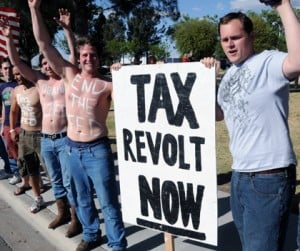
A scene from the first tea party held in Las Cruces on April 15. (Photo by Heath Haussamen)
9. Tea parties
About 400 people showed up at the first tea-party rally held in Las Cruces in April. That was part of the movement’s first nationwide rally and was a show of force from those fed up with government spending, taxation and other issues.
But across much of the nation, tea-party events on the Fourth of July and at other times appeared to shrink, and the question became whether the tea parties were a one-time event or a new movement. A week after the April rally, supporters of the tea party movement in Las Cruces failed to show up at a meeting about a proposed quality-of-life tax increase and prove that they were ready to do more than stand on street corners and wave signs.
In September, the tea party movement showed new life in Las Cruces. At least 1,200 people showed up for a protest when the Tea Party Express rolled through town. FOX News broadcast live from the event.
Similar rallies in Albuquerque and El Paso were much smaller.
With the libertarian-leaning former N.M. Gov. Gary Johnson doing nothing to quell calls for him to run for president in 2012, the support the tea party movement appears to enjoy in cities like Las Cruces keeps things interesting.
8. Death penalty repeal
It wasn’t much of a surprise when Gov. Bill Richardson signed a long-sought repeal of the death penalty into law in March, but it was a relief and an emotional moment for opponents of the death penalty who had sought the ban for a long time.
Many, including the GOP’s Darren White, aren’t ready to give up the fight yet. White started a political action committee in March with the goal of repealing the state’s death penalty repeal. The PAC’s goal may not have much momentum, at least in the short term (at least it hasn’t shown momentum yet), but look for the GOP to try to make this an election-year issue in 2010.

Diane Denish
7. 2010 election looms
Politics never seem to stop anymore. The 2010 election got into full swing in 2009. Republicans set their sights on the Democrats’ likely nominee for governor – Lt. Gov. Diane Denish – knowing that defeating her next year is critical if the state’s minority party is to have any say in the redistricting that will take place in the next decade.
Tying Denish to scandals that have plagued the Richardson administration is the primary tactic of the state Republican Party and at least two of four Republican gubernatorial candidates.
The GOP’s other primary target appears to be U.S. Rep. Harry Teague, D-N.M. It became clear early in 2009 that the race between Teague and his predecessor, Steve Pearce, R-N.M., will be one of the hottest U.S. House contests in the nation in 2010. Anger over Teague’s support of cap-and-trade legislation earlier this year only makes this race more interesting.
In addition to the Republican primary for governor, there are hotly contested primaries for both parties’ nominations for lieutenant governor and land commissioner. 2010 promises to be a fascinating election year in New Mexico.
6. Progressives gain more ground in Las Cruces
Progressives took control of city government in Las Cruces in 2007 and 2008 with surprising election victories. They grabbed even greater influence in 2009 when progressive-backed candidates unseated two more incumbents.
Progressives now control five of six seats on the city council, and the mayor also enjoys the support of progressives. The state Democratic Party was quick to tout the November election as a sign of good things to come for Democrats in 2010.
Las Cruces appears to be bucking the national trend that is currently swinging toward the GOP in many areas. That’s especially important to consider in the context of next year’s race between Teague and Pearce. Pearce is certain to do well on the conservative east side of the district. Teague needs a significant win in Las Cruces.
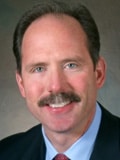
Richard Berry
5. GOP takes over Albuquerque
In October, voters unseated longtime Albuquerque Mayor Martin Chávez, replacing him with Richard Berry, the city’s first Republican mayor since the 1980s. But that wasn’t the extent of the GOP gains: Republicans also took control of the Albuquerque City Council.
In a state in which Republicans have seen so few victories in recent years, and coming off the Barack Obama wave that was 2008, Republicans in New Mexico and nationally looked to their success in the Albuquerque election as a sign of good things to come in 2010. Are they right? Time will tell.
Regardless, the contrast between the GOP’s big wins in Albuquerque and progressives’ big wins in Las Cruces is stunning. The big question for 2010 is whether new voters who came out for Obama in 2008 will vote again in 2010 – and if they do, will they stick with Democrats or more around the political map?
One thing is likely: Berry won in part because the city’s public financing system leveled the playing field. Look for many Republicans in the state Legislature to express less resistance to expanding the state’s public financing system in the future. Were there money in the budget – which there isn’t – we might even see an expansion in 2010.
4. Government transparency increases
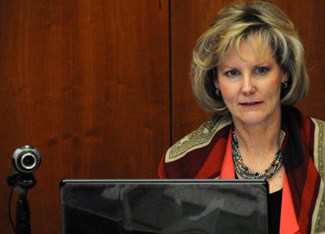
State Rep. Janice Arnold-Jones webcasting a committee meeting earlier this year. (Photo by Heath Haussamen)
New Mexico took a surprising and refreshing leap forward in the area of government transparency in 2009. It started when State Rep. Janice Arnold-Jones, R-Albuquerque, took a Web cam with her to legislative committee meetings and started webcasting, coming close to breaking House rules and daring leadership to stop her.
With the public and media watching, leadership didn’t stop her. As the New Mexico Independent, KUNM radio, two other Republican lawmakers and others joined in the webcasting, the House and Senate were quick to regulate the new fad, with the House approving official, audio-only webcasting and the Senate approving audio and video – from one camera in the back of the chamber.
Baby steps forward, to stay the least, but still steps forward.
The Legislature took other steps forward in the area of transparency. They approved a long-sought proposal to open legislative conference committees to the public, which immediately proved to be a good thing; increased the frequency that candidates must submit campaign finance reports; and changed the state’s Inspection of Public Records Act to require that government agencies respond to records requests submitted via e-mail.
In addition, there were some visible victories for transparency this year when three agencies that had previously refused to release subpoenas they’d received as part of ongoing investigations — the New Mexico Finance Authority, State Investment Council and Educational Retirement Board — reversed courses and released them (The ERB first, then the NMFA, then SIC).
The lone holdout? Richardson’s office. He played fast and loose with the public records act, blacklisted me and gave other journalists a hard time. Richardson’s refusal to be transparent leaves him with a black eye as the Legislature and even some government agencies under his control are doing the opposite.
With the scandals surrounding Richardson continuing to taint close friends of the governor, I can’t help but wonder if he’s refusing to be transparent because he has something to hide.
3. Mr. Richardson doesn’t go to Washington
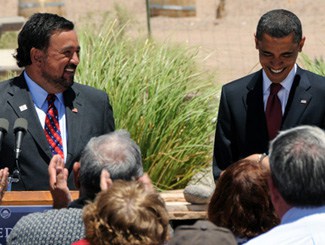
Barack Obama and Bill Richardson sharing a laugh in Las Cruces in 2008. (Photo by Heath Haussamen)
We knew in August 2008 that the FBI was investigating allegations that CDR Financial Products received a state investment contract that paid almost $1.5 million in exchange for $110,000 in contributions to two Richardson political committees and his 2006 gubernatorial re-election campaign. Despite the warning signs, we knew in November 2008, or at least when it became official in December 2008, that Obama had chosen Richardson to be his commerce secretary.
Richardson’s political ambitions collided with the investigation in January when he withdrew his nomination to be commerce secretary. At the time, Richardson and Obama portrayed the move as temporary.
“I look forward to his future service to our country and in my administration,” the president said of Richardson.
That made the dramatic plunge Richardson took in the following weeks and moths even more shocking. Obama made a joke on national television at Richardson’s expense days after the governor withdrew his nomination. Richardson’s approval rating tanked. The media started more intensely scrutinizing the governor and his administration.
Two more cases – a whistleblower lawsuit filed by former ERB Investment Officer Frank Foy and the national investment scandal that’s already led to convictions in New York – further tainted the Richardson administration. When the U.S. attorney confirmed in August of this year that Richardson wouldn’t be charged in the CDR probe, political analysts were quick to point out that the governor wasn’t yet in the clear.
In making known that Richardson and others his office investigated were not exonerated, the U.S. attorney reserved the right to reopen the case at any time. CDR officials were later indicted in a separate case not related to New Mexico.
At the end of the year, the man who came back to New Mexico in 2002 with his eyes on winning the presidency in 2008 remains instead a lame-duck governor whose future is unclear.
2. Economic downturn
Bailouts in Washington appeared to begin to stabilize – at least temporarily – the nation’s economy in 2009. But the situation remained bad throughout the year, and New Mexico wasn’t immune to the greatest economic downturn since the Great Depression.
This isn’t the top New Mexico political and government story of 2009, in my opinion, because the state’s leaders haven’t yet dealt with the situation – meaning much of the hard work and much of the pain is yet to come.
Lots of pain has already been felt. For example, many newspapers made drastic cuts this year. The housing market has tanked. Oil and gas revenues are still down. But government, by far the largest employer in New Mexico, avoided making the most difficult decisions, in part because it used one-time, federal stimulus money to help prop up the state budget.
The governor started making painful moves recently with the announcements of mandatory furloughs and layoffs of 59 political appointees, but there’s more to come. Left to deal with in the upcoming session is a budget shortfall of at least several hundred million dollars. Some say the shortfall could be as much as $1 billion.
Many agree that tax increases or other revenue raisers and massive cuts will be necessary. The debate over both threatens to create gridlock in the Legislature, and the fact that 2010 is an election year introduces another dynamic — some will be thinking more about doing what’s politically wise than what’s necessary.
Regardless, lawmakers and the governor failed to make the hard choices in 2009, so, unless more federal stimulus money is approved, they’ll have to make those decisions in 2010.
1. Public corruption
Former Region III Housing Authority Director Vincent "Smiley" Gallegos
Though rumors of pending indictments of Richardson or others in the CDR case never came to fruition, several other public corruption cases led to criminal indictments in 2009:
• In April, the attorney general secured the indictments of Public Regulation Commissioner Jerome Block Jr. and his father, a former PRC member, on felony charges related to misusing the state’s public financing system.
• In June, former Region III Housing Authority Director Vincent “Smiley” Gallegos and others were indicted in the long-standing housing authority scandal. The charges against three of the four, including Gallegos, include fraud and money laundering.
• In July, former Secretary of State Rebecca Vigil-Giron and three others were indicted on 50 counts including money laundering, fraud, soliciting or receiving kickbacks and tax evasion in the alleged theft of millions of dollars.
Those three cases — plus the now-defunct probe into the Richardson administration and CDR, the investment scandal and a massive embezzlement in the Jemez Mountain School district — made corruption an even more prominent story in 2009 than the economy.
In the case of the investment scandal, here’s what we know: Former State Investment Office Gary Bland, according to SIC member and Land Commissioner Patrick Lyons, was allegedly pushing investment firms to hire certain placement agents. Aldus Equity’s Saul Meyer, when he was the state’s investment adviser, was recommending that the state make investments that were pushed on him by politically connected individuals even though, by his own admission, those investments may not have been in the best interest of the state.
And Marc Correra, a politically connected placement agent (his father is a close friend of the governor) who shared in as much as $22 million in finders’ fees for helping investment companies win business with the state, has apparently gotten out of Dodge.
Meyer, who has already pleaded guilty to charges in New York, is reportedly cooperating with investigators in New Mexico. Look for something to happen with this case in 2010.
The scandals pushed the Legislature to approve campaign contribution limits earlier this year that will take effect shortly after the 2010 election. Many are laying the groundwork for another push to create a state ethics commission to educate public officials on how to behave (yes, they apparently need such education) and punish them when they don’t.
There are calls for other reforms too, including the creation of a whistleblower protection law and the banning of contributions from state lobbyists and contractors. And the AG is coming under pressure to act on almost 100 cases filed under the Fraud Against Taxpayers Act that remain sealed.
Starting with the indictments of two state treasurers in 2005, the second half of the decade has exposed deep-rooted public corruption in New Mexico. But have we started turning things around?
That may be the biggest question as we enter 2010.